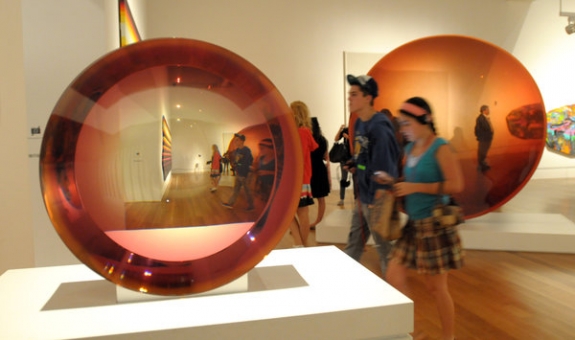For the next six months, Southern California will be awash in celebrations of Southern California art: close to 170 separate exhibitions at 130 museums and galleries stretching from San Diego to Los Angeles to Santa Barbara. Pacific Standard Time, as this festival is known, is an exhaustive accounting of the birth of the Los Angeles-area art scene, but it is also a statement of self-affirmation by a region that, at times, appears to feel underappreciated as a serious culture center.
This multi-museum event, in all of its Los Angeles-like sprawl, suggests a bit of overcompensation from a city that has long been overshadowed by the New York art establishment, a place that — arguably unfairly — still suffers from a reputation of being more about tinsel than about serious art, and where interest in culture starts and ends with movie grosses and who is on the cover of Vanity Fair.
“It’s corny,” said Dave Hickey, an art critic and a professor in the art and art history department at the University of New Mexico. “It’s the sort of thing that Denver would do. They would do Mountain Standard Time. It is ’50s boosterish, and I would argue largely unnecessary.”
Still, for many Los Angeles artists and critics, Pacific Standard Time: Art in L.A. 1945-1980, is a long-needed accounting of the emergence of the region as an art capital in the same league as New York, Berlin and London. Indeed, Los Angeles these days has more than its share of ambitious museums, adventurous art galleries, wealthy collectors, top-notch art schools and — perhaps most important — young artists drawn here by relatively cheap rents, abundant light and an atmosphere that encourages experimentation.
“Since 1980 the art world has become global — New York is not the epicenter,” said Peter Plagens, a painter and essayist who has worked extensively in Southern California and who was here for some of the openings. “So L.A. is kind of doing this joust: ‘We want our art history to be in the books.’ ”
The shows cover the postwar outpouring of art from the Southern California region. The festival will run for half a year, and just as well: art enthusiasts intent on seeing all the exhibitions are approaching this as the art world equivalent of an Ironman Triathlon.
“I am going to treat it like a graduate course in art history,” said Jeffrey Deitch, the director of the Museum of Contemporary Art in Los Angeles.
For less determined mortals, highlights can be seen at the Getty, which features works by Los Angeles sculptors and artists like Ed Ruscha and George Herms, from 1950 to 1970; the Los Angeles County Museum of Art, with an exhibition of California-inspired modern furniture design and a retrospective of work by the Chicano performance and Conceptual art group Asco; the Museum of Contemporary Art in San Diego, with a light and space exhibition; the Norton Simon Museum in Pasadena, with a display of prints; and the Hammer Museum at the University of California, Los Angeles, with work by local African-American artists.
In many ways, this multi-museum extravaganza goes against type, or at least stereotype. “It’s a coming of age for a city that sometimes doesn’t think of itself as having an art history,” said Michael Govan, the executive director of the county museum.
That novelty alone seems likely to feed curiosity about what is taking place here. “Los Angeles just presents itself as a fresh and new story — people will be interested in hearing some different narrative they haven’t heard before,” said Thomas E. Crow, an art historian. “And because so much of the art is really, really good, that will sustain the interest in these new narratives.”
No one is suggesting that Los Angeles is about to supplant New York as an art capital; it is not lost on people here that the executive directors of three of the four biggest museums in Los Angeles came here from New York. James Cuno, the president of the J. Paul Getty Trust, which is financing the event, noted the abundance of galleries, auction houses and money in New York.
“It’s understandable that artists and collectors would find their way there,” he said. “In the art world, the world tilts to New York. New York has been dominant and held our imagination since the late 1950s. That has cast everyone else in the shadows.”



